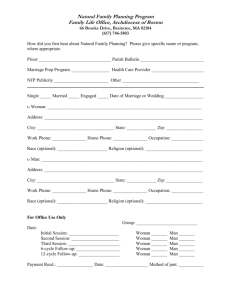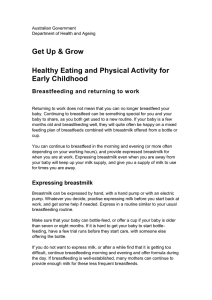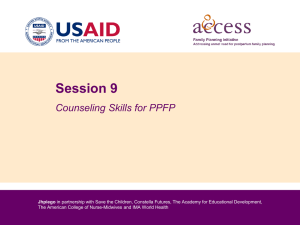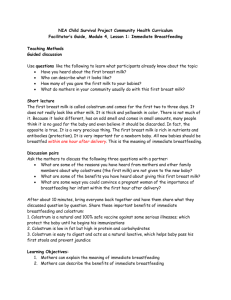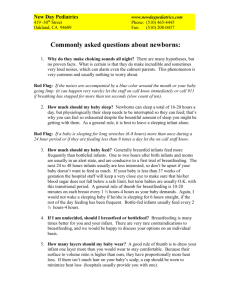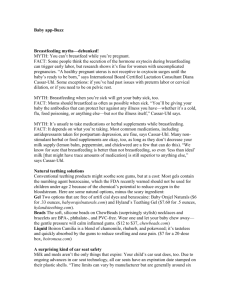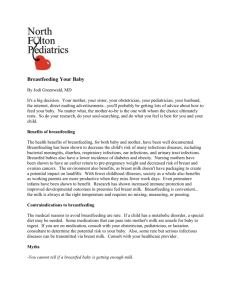Breastfeeding Basics - Prenatal Class
advertisement
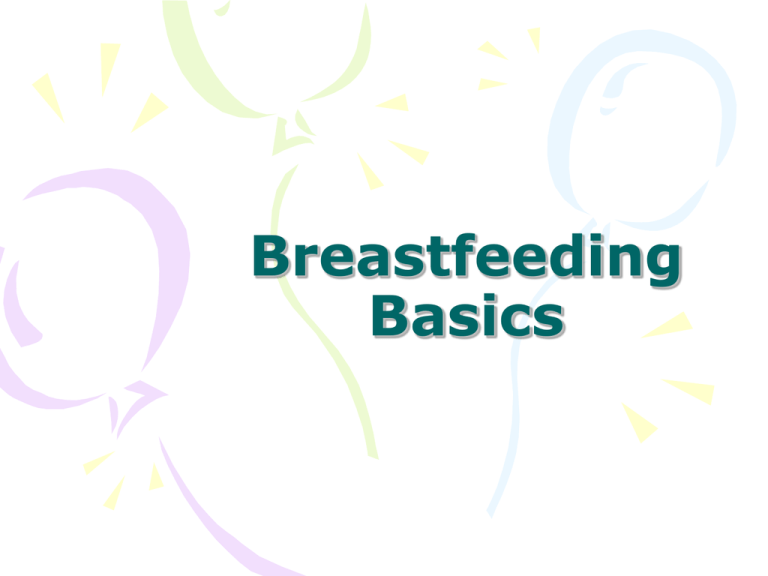
Breastfeeding Basics Will I Have Enough Milk? Calibrated in the first few days Based on how much milk is removed Early and often Steps for success • Feed the Baby • Move the Milk • Keep Mom & Baby together Do I have to change my lifestyle? • Mothers DO NOT have to have a “perfect” diet to successfully lactate. • Listen and Respond to your bodies’ message. – Eat when you’re hungry – Drink when you’re thirsty – Rest when you’re tired • Alcohol: – Moderation advised – If mother feels intoxicated breastmilk contains alcohol and should not be given to infant – When mother no longer feels the effects of alcohol breastmilk has safe levels of alcohol • Nicotine: – Excessive nicotine intake decrease milk supply. Nicotine: – Mother’s should not smoke during breastfeedings – Increases secondary smoke exposure – Secondary smoke increases incidence or URTI, bronchitis, pneumonia, SIDS, leukemia etc. Getting off to a good start: • Ideally, infant is placed to breast IMMEDIATELY after birth. • Breastfeeding should be initiated within first hour after birth How Often to Breastfeed • Guidelines: – Feed at least every 3 hours during the day (8-12 feedings each 24 hrs) – Feed at least 5-10 minutes each side – Listen for swallowing – Watch infant for satiety cues – Avoid intense clock watching Dad’s Special Role • Supporting decision to breastfeed • Provide encouragement • Bringing infant to a responsive state for feeding • Supporting mother nutritionally by preparing nutritious snack • Helping with household tasks How do I know if baby is Getting Enough Milk? 8 to 12 feedings each 24 hours Feed your baby at least 8 times each day. Notice that your baby swallows often At Least 4 Bowel Movements Each day After baby is 4 days old he should have at least 4 bowel movements each day. (Bowel movements should be yellow by 5 to 7 days after birth) • Contentment After Feedings – Your baby should be relaxed and satisfied after most feedings – Your baby should not cry, suck her hands, “root” or need a pacifier after most feedings. – Your baby’s fists and elbows should be relaxed (not clinched or tightly flexed) after feedings. – It is better to minimize pacifier use until breastfeeding is well established and your baby is gaining weight (usually after two weeks) • Breastfeeding Should Not be Painful – Some mothers notice mild nipple tenderness in the first week. If it is painful to breastfeed, your baby may not be latching-on correctly and your baby may not be getting enough milk Make sure that your baby’s nose tip and chin are touching your breast! Breastfeeding challenges are more easily solved if you get help early

